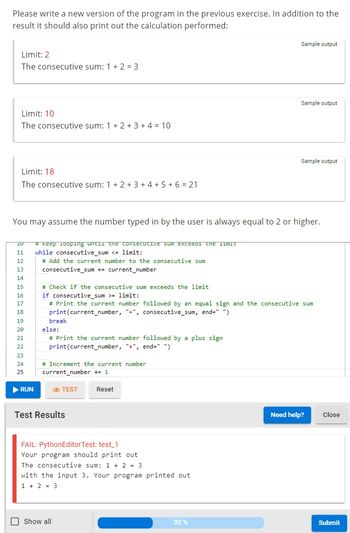Limit: 2 The consecutive sum: 1 + 2 = 3 Limit: 10 The consecutive sum: 1+ 2+ 3+ 4 = 10 Limit: 18 The consecutive sum: 1+ 2+ 3+ 4+ 5+ 6 = 21 Sample output Sample output Sample output
Limit: 2 The consecutive sum: 1 + 2 = 3 Limit: 10 The consecutive sum: 1+ 2+ 3+ 4 = 10 Limit: 18 The consecutive sum: 1+ 2+ 3+ 4+ 5+ 6 = 21 Sample output Sample output Sample output
Database System Concepts
7th Edition
ISBN:9780078022159
Author:Abraham Silberschatz Professor, Henry F. Korth, S. Sudarshan
Publisher:Abraham Silberschatz Professor, Henry F. Korth, S. Sudarshan
Chapter1: Introduction
Section: Chapter Questions
Problem 1PE
Related questions
Question
Can you use Python
Thank you very much!

Transcribed Image Text:Please write a new version of the program in the previous exercise. In addition to the
result it should also print out the calculation performed:
Limit: 2
The consecutive sum: 1 + 2 = 3
Limit: 10
The consecutive sum: 1 + 2 + 3 + 4 = 10
Limit: 18
The consecutive sum: 1+ 2+ 3+ 4+ 5+ 6 = 21
Sample output
1 # Write your solution here
Sample output
Sample output
You may assume the number typed in by the user is always equal to 2 or higher.
Expert Solution
This question has been solved!
Explore an expertly crafted, step-by-step solution for a thorough understanding of key concepts.
This is a popular solution!
Trending now
This is a popular solution!
Step by step
Solved in 3 steps with 2 images

Follow-up Questions
Read through expert solutions to related follow-up questions below.
Follow-up Question
Hello,Its not correct...Can you help me?

Transcribed Image Text:Please write a new version of the program in the previous exercise. In addition to the
result it should also print out the calculation performed:
Limit: 2
The consecutive sum: 1 + 2 = 3
Limit: 10
The consecutive sum: 1+ 2+ 3+ 4 = 10
Limit: 18
The consecutive sum: 1+ 2+ 3+ 4+ 5+ 6 = 21
10
11
12
13
14
15
16
17
18
19
20
21
22
23
24
25
You may assume the number typed in by the user is always equal to 2 or higher.
▶ RUN
# Keep looping until the consecutive sum exceeds the limit
while consecutive_sum <= limit:
# Add the current number to the consecutive sum
consecutive_sum += current_number
break
else:
# Print the current number followed by a plus sign
print(current_number, "+", end=" ")
# Check if the consecutive sum exceeds the limit
if consecutive_sum >= limit:
# Print the current number followed by an equal sign and the consecutive sum
print(current_number, "-", consecutive_sum, end=" ")
# Increment the current number
current_number += 1
TEST
Test Results
Reset
FAIL: PythonEditorTest: test_1
Your program should print out
The consecutive sum: 1 + 2 = 3
Show all
with the input 3. Your program printed out
1 + 2 = 3
Sample output
Sample output
33 %
Sample output
Need help? Close
Submit
Solution
Knowledge Booster
Learn more about
Need a deep-dive on the concept behind this application? Look no further. Learn more about this topic, computer-science and related others by exploring similar questions and additional content below.Recommended textbooks for you

Database System Concepts
Computer Science
ISBN:
9780078022159
Author:
Abraham Silberschatz Professor, Henry F. Korth, S. Sudarshan
Publisher:
McGraw-Hill Education

Starting Out with Python (4th Edition)
Computer Science
ISBN:
9780134444321
Author:
Tony Gaddis
Publisher:
PEARSON

Digital Fundamentals (11th Edition)
Computer Science
ISBN:
9780132737968
Author:
Thomas L. Floyd
Publisher:
PEARSON

Database System Concepts
Computer Science
ISBN:
9780078022159
Author:
Abraham Silberschatz Professor, Henry F. Korth, S. Sudarshan
Publisher:
McGraw-Hill Education

Starting Out with Python (4th Edition)
Computer Science
ISBN:
9780134444321
Author:
Tony Gaddis
Publisher:
PEARSON

Digital Fundamentals (11th Edition)
Computer Science
ISBN:
9780132737968
Author:
Thomas L. Floyd
Publisher:
PEARSON

C How to Program (8th Edition)
Computer Science
ISBN:
9780133976892
Author:
Paul J. Deitel, Harvey Deitel
Publisher:
PEARSON

Database Systems: Design, Implementation, & Manag…
Computer Science
ISBN:
9781337627900
Author:
Carlos Coronel, Steven Morris
Publisher:
Cengage Learning

Programmable Logic Controllers
Computer Science
ISBN:
9780073373843
Author:
Frank D. Petruzella
Publisher:
McGraw-Hill Education